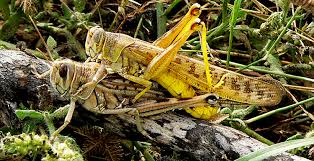By Muhammad Luqman
The pestilent species of grasshopper that was first observed in large numbers in Khairpur , has spread to at least six more districts in Pakistan’s southern province of Sindh. The large scale attack of these locusts has caused fears of a massive cotton crop devastation.
The locusts have been spotted in areas including Dadu, Matiari, Jamshoro, Nawabshah, Naushehro Feroze and Sanghar districts, according to media reports.
“Locusts can destroy the agricultural belt of Sindh if they entered Mirpurkhas, Tando Allahyar, Matiari, Hyderabad and other districts on the left bank of Indus River,” warns Sindh Chamber of Agriculture General Secretary Zahid Hussain Bhurgari.
He feared , if the authorities failed to control the insects, the agriculture sector would suffer huge financial losses of billions of rupees. “Locust attacks are increasing each passing day,” he said and urged the government to carry out aerial and ground operations to kill the insects.
Sindh Abadgar Board Vice President Syed Mehmood Nawaz Shah has asked Pakistan’s central government to launch an international appeal for help.
“Monsoon season is round the corner in which locusts multiply faster, hence an international appeal needs to be made,” said Shah,
He lamented that the first generation of locusts in Balochistan could not be controlled by the Department of Plant Protection (DPP) and now the second generation had invaded Sindh’s Khairpur, Dadu, Nawabshah, Matiari and Sanghar districts. He cautioned that locusts might cause extensive damage as they had now entered areas heavily cultivated with vegetables.
Locusts, which caused a huge damage to Pakistan’s agriculture back in the 1950s, 1960s and 1990s, have once again swarmed Balochistan and Sindh provinces.
Climatically, these species require sandy area with moisture where they can feed and breed. These insects prefer to live in desert areas but if they fail to find a suitable environment, they turn towards crops. Last epidemics of locusts were witnessed in 1993 and 1997 in Pakistan. There were other small-scale attacks as well but owing to well-coordinated efforts the country was able to thwart the threat without suffering any significant damage.
This time, the locusts first appeared in Sudan and Eritrea in Africa from where they migrated to Yemen and Saudi Arabia and reached Iran where they hit an area of 400,000 square kms and seven regions in March this year.
After that, the insects advanced towards the coastal belt of Pasni and Turbat in Pakistan.
The locusts continued to enter Pakistan from Iran as the neighbouring country was unable to fully contain the pest and recent rains throughout Pakistan provided them a favourable environment, which aggravated the situation. Khan pointed out that five teams of the DPP were surveying and conducting operations in Turbat, Dasht, Gwadar, Jiwani, Lasbela, Khuzdar, Uthal, Kharan, Dalbandin, Washiq and other places. A DPP team is also working in the affected areas of Sindh.















